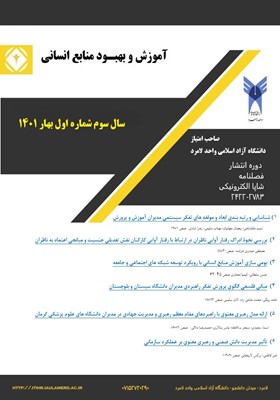بررسی نحوۀ ادراک رفتار آوایی ناظران در ارتباط با رفتار آوایی کارکنان نقش تعدیلی جنسیت و میانجی اعتماد به ناظران
محورهای موضوعی : مدیریت منابع انسانی
1 - استادیار، گروه اقتصاد و مدیریت، واحد نراق، دانشگاه آزاد اسلامی، نراق، ایران
کلید واژه: ", ", رفتار آوایی کارکنان ", رفتار آوایی ناظران ", جنسیت ", اعتماد به ناظران ",
چکیده مقاله :
هدف تحقیق حاضر بررسی نحوۀ ادراک رفتار آوایی ناظران در ارتباط با رفتار آوایی کارکنان خود به صورت مستقیم و غیرمستقیم و با اعتماد به ناظران است و به طور خاص، نقش تعدیلی جنسیت را در ارتباط بین اعتماد به ناظر و رفتار آوایی کارکنان بررسی می-کند. نحقیق حاضر از نظر هدف، کاربردی و از نظر شیوه گردآوری و تحلیل اطلاعات و داده ها به ترتیب توصیفی- پیمایشی و پرسشنامه و از نوع علی است جامعه آماری تحقیق شرکت ملی نفت ایران شامل 250 نفر که به صورت تصادفی ساده ، نمونه ی 148 تعیین و تشویق به پاسخ دهی شدند .جهت جمع آوری داده ها از پرسشنامه های استاندارد رفتار آوایی ناظران و کارکنان ماینس و پودساکوف (2014) و اعتماد به ناظر مکآلیستر (1995) و جهت تجزیه و تحلیل داده ها از تحلیل رگرسیون سلسله-مراتبی و فرایند ماکرو هایز استفاده شد. نتایج نشان داد : رفتار آوایی کارکنان به شکلی مثبت با رفتار اوایی کارکنان همراه است، اعتماد به ناظر در میانۀ ارتباط میان رفتار آوایی ناظر و رفتار آوایی کارکنان قرار دارد؛ جنسیت ارتباط میان اعتماد به ناظر و رفتارهای آوایی کارکنان را تعدیل میکند و جنسیت تأثیر غیرمستقیم رفتار آوایی ناظر را بر رفتار آوایی کارکنان از طریق اعتماد به ناظر تعدیل میکند. مطالعه حاضر درک کارکنان را از رفتار آوایی ناظران بررسی میکند که این رفتار کارکنان را در جهت ارتقا تشویق میکند، بدینوسیله درکی دقیق از عواملی را ارائه میکند که رفتار آوایی کارکنان را آسان میکند.
The purpose of this study is to investigate the Perceived Supervisors’ Voice Behavior in Relation to the Employees’ Own Voice Behavior directly and indirectly and with confidence in supervisors. In particular, it examines the moderating role of gender in the relationship between observer confidence and Employees’ Own Voice Behavior.The present research is applied in terms of purpose and in terms of method of collecting and analyzing information and data, respectively descriptive-survey and questionnaire and is of causal type. The statistical population of the research of the National Iranian Oil Company includes 250 people who were randomly selected, sample 148 and were encouraged to respond.To collect data from the standard questionnaires of Perceived supervisor’s voice behavior and Employees’ Own Voice Behavior by Maynes andPodsakoff (2014) and Trust in supervisor by McAllister (1995) and hierarchical regression analysis and Hayes’ PROCESS macro were used to analyze the data. The results showed: the perceived supervisor’s voice behavior was positively associated with employeevoice behavior; trust in supervisor mediated the relationship between perceived supervisor’s voice behavior and employee voice behavior; gender moderated the relationship between trust in supervisor and employee voice behaviors; and gender moderated the indirect effect of perceived supervisor’s voice behavior on employee voice behavior via trust in supervisor.The current study investigates employees’ perception of immediate supervisor’s voice behavior that encourages employees to speak up, thereby providing a more nuanced understanding of the factors that facilitate employee voice behavior. I
_||_

